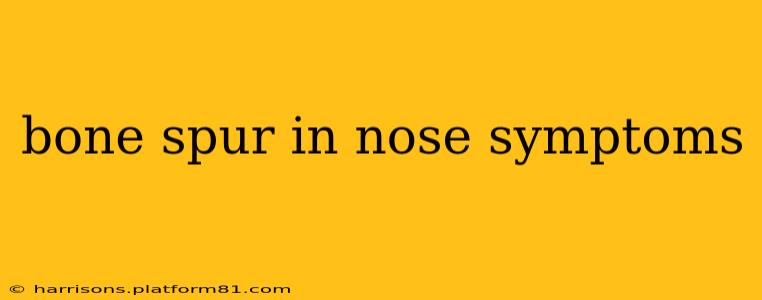A bone spur in the nose, also known as a nasal bone osteophyte, is a bony outgrowth that develops on the nasal bones. While often asymptomatic, they can cause a range of symptoms depending on their size, location, and whether they impinge on surrounding structures. Understanding the potential symptoms, causes, and treatment options is crucial for effective management.
What are the symptoms of a bone spur in the nose?
Many individuals with nasal bone spurs experience no symptoms at all. However, when symptoms do occur, they can vary widely. The most common symptoms include:
- Nasal Obstruction: This is a feeling of stuffiness or blockage in one or both nostrils, potentially making breathing through the nose difficult. The severity depends on the spur's size and location.
- Nasal Congestion: Similar to obstruction, but can also be accompanied by a feeling of pressure or fullness in the nose.
- Nosebleeds (epistaxis): The bony outgrowth can irritate the delicate nasal lining, making it more prone to bleeding, especially during dry conditions or forceful nose blowing.
- Facial Pain or Pressure: Depending on the location and size of the spur, it might press against surrounding nerves or tissues, causing pain or pressure in the face, particularly around the nose and forehead.
- Headaches: In some cases, a nasal bone spur can contribute to headaches, possibly due to the pressure it exerts or its effect on nasal airflow.
- Sinus Infections (Sinusitis): A bone spur can sometimes obstruct sinus drainage, increasing the risk of sinusitis. Symptoms of sinusitis include facial pain, pressure, congestion, and sometimes fever.
What causes a bone spur in the nose?
The exact cause of nasal bone spurs isn't fully understood, but several factors are believed to contribute:
- Age: Bone spurs are more common in older adults, likely due to the cumulative effects of aging and wear and tear on the bones.
- Trauma: A previous nasal injury, such as a fracture or impact, can sometimes lead to the development of bone spurs as the bone heals.
- Infection: Chronic inflammation or infection in the nasal cavity could potentially stimulate bone growth, leading to spur formation.
- Genetics: While not a primary cause, a genetic predisposition to bone spurs may play a role in some individuals.
Can a bone spur in the nose cause breathing problems?
Yes, a bone spur in the nose can definitely cause breathing problems, particularly nasal obstruction and congestion. If the spur is large enough to significantly narrow the nasal passages, it can make breathing through the nose difficult or even impossible. This can lead to mouth breathing, which can have further negative consequences, such as dry mouth and throat irritation.
How is a bone spur in the nose diagnosed?
Diagnosis typically involves a physical examination of the nose and nasal passages by an otolaryngologist (ENT doctor). The doctor will use a nasal speculum to visualize the inside of the nose and assess the presence of any bony growths. Sometimes, additional imaging studies like X-rays or CT scans may be necessary to better visualize the spur and rule out other potential causes of symptoms.
What are the treatment options for a bone spur in the nose?
Treatment for a nasal bone spur depends on the severity of symptoms. If the spur is asymptomatic, no treatment is usually necessary. However, if symptoms are bothersome, treatment options include:
- Medication: Nasal corticosteroids or saline sprays can help alleviate congestion and inflammation. Pain relievers can help manage pain and discomfort.
- Surgery: In cases of significant nasal obstruction or other debilitating symptoms, surgery may be necessary to remove the bone spur. This is typically performed under local anesthesia and involves a minimally invasive procedure.
When should I see a doctor about a possible bone spur in my nose?
You should consult a doctor if you experience persistent nasal congestion, obstruction, pain, or frequent nosebleeds that you suspect might be related to a bone spur. Early diagnosis and appropriate management can help prevent complications and improve your quality of life.
Disclaimer: This information is for educational purposes only and should not be considered medical advice. Always consult with a qualified healthcare professional for diagnosis and treatment of any medical condition.
